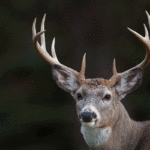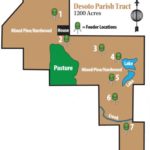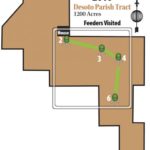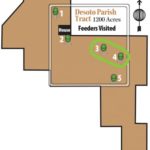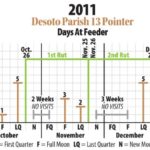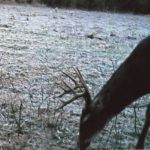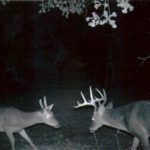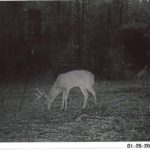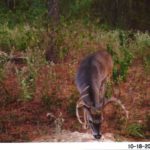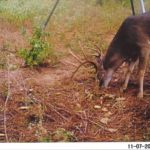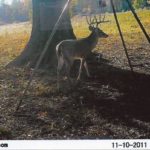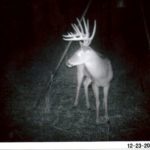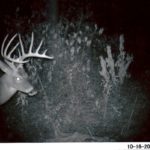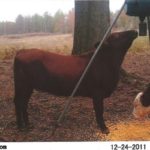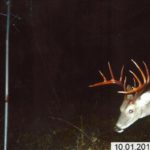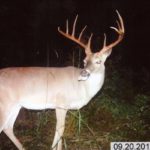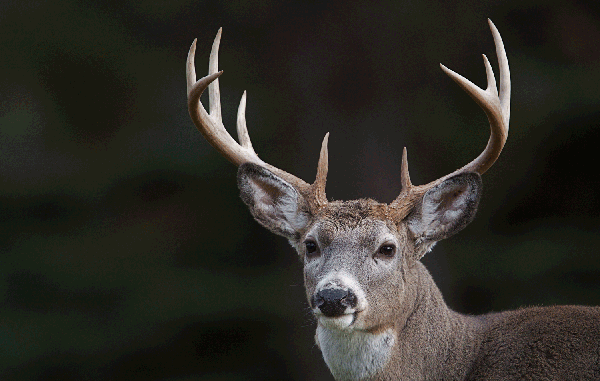
A three-year trail camera project reveals some interesting habits of a Boone & Crockett-class buck in the state’s northwest piney woods.
Wildlife research is conducted to learn information about a particular species. Where does it live? What does it eat? What is its breeding chronology? What are its habits?
I think you get the idea. The study is then designed to obtain the desired information.
From a hunter’s standpoint, some of the knowledge gained from a study might not actually be of use to the hunter in his pursuit of the quarry. From the wildlife biologist’s viewpoint, all information can be beneficial for the proper management of the species.
Wildlife research is not cheap; it can be very expensive, especially when it concerns big-game animals such as whitetail deer. Much of the research being done today incorporates modern technology developed over the past 20 years, and it comes with a very nice price tag.
For instance, LDWF’s Scott Durham is initiating a deer study in Louisiana with the University of Georgia that will be looking at fawn survival and recruitment, especially concerning depredation by coyotes and bears.
This study will involve capturing pregnant does and then capturing their fawns when they are born, and will require the use of high-tech tools.
LDWF also has recently completed two telemetry studies that investigated the home ranges and survival of deer on a bottomland hardwood tract in South Louisiana and on a North Louisiana pine habitat site.
The department is fortunate that most of these research projects are funded with federal dollars. Our game department is working hard to manage our deer resource using the latest management tools and technology, and we deer hunters should be ready and willing to support them in this effort.
Not all studies require the use of expensive high-tech materials and equipment that Durham and other researchers will be using. Trail cameras that are ready available to the hunting community provide hunters and managers with a high-tech tool and comes with a price tag much less than GPS animal collars.
Telemetry units will tell the biologist locations of deer and where the animal has been, but they do not tell you what the animal is doing. Trail cameras document what the animal is doing at a particular location like a feeding site or scrape, but cannot tell the biologist where the animal went when it left that location.
Research that would utilize both tools will give the biologist greater insight as to the deer’s movement and activities, but I am not sure the technology for this is available, yet.
Although I retired from LDWF in 2007, I have tried to remain active with the deer-management community and the latest research developments, especially the application of this research for hunters. The two telemetry studies completed by LDWF provided good insight as to the home ranges of deer in the Bayou State.
Durham has prepared reports that are available on the LDWF Web site that shows the results of these studies.
Deer in Louisiana, particular bucks, were found to have smaller home ranges than that of deer in studies from other states. This information supports the idea that small landowners can keep bucks on their land by utilizing sound habitat practices.
It also shows that hunters can have success on small properties with a buck-management program.
In 2009, a relative of mine in Shreveport purchased a 1,200-acre tract of land in Desoto Parish. In the fall of 2010, he asked me to help develop a wildlife program for the tract.
He does not allow hunting on the property, but he likes visitors to be able to see wildlife — especially deer.
I did some basic survey work, and then set up seven feeders at various locations. The feeders would be in operation during the fall and winter and for a while during spring. A few sites were planted with rye grass and clover.
I was also interested in learning if this area had a turkey population. Trail cameras were placed at various locations.
The feeding sites were as follows:
• No. 1 — North Feeder
• No. 2 — Sawtooth Oak Feeder
• No. 3 — White Oak Feeder
• No. 4 — Willow Oak Feeder
• No. 5 — Crawfish Pond Feeder
• No. 6 — North Bayou Feeder
• No. 7 — South Bayou Feeder
Map 1 shows the location of these feeders and feeding sites on the property. Corn and rice bran were used at the sites.
Again the purpose of this project was simply to make deer visible on the property and to document the present deer herd population with the trail cameras. Since the tract would not be hunted, I have concerns that the population could at some point become too much for the habitat, resulting in both herd and habitat issues.
A 10-pointer in 2010
It was evident from the initial photographs that, prior to my relative purchasing this tract, that it had been hunted pretty hard (the number of deer stands on the property was a good clue regarding this also).
Does and fawns, along with a few yearling bucks, dominated most of the photographs.
There were a few low-end adult bucks, including a couple of big 6-pointers, and a couple of adults with oddball racks.
To my surprise, however, a very nice 10-point was documented in the first set of photographs at the Sawtooth Oak Feeder. This 10-pointer did not have heavy antler mass, but did have good main beam lengths and excellent G-2s and G-3s.
I had scored a bow-killed buck from Desoto Parish that looked very much like this deer, and that deer scored 140 Boone & Crockett. I included this buck in my Shoot-Don’t Shoot section of my book Louisiana Whitetails and suggested that a bow hunter would want to harvest it and make the Pope & Young Record Book, while a gun hunter would be wise to pass it up and let it grow another year.
The buck was photographed at four feeders during the 2010-11 deer season. Most of the photographs were taken at the Sawtooth Oak Feeder, the White Oak Feeder and the Willow Oak Feeder, and it was photographed once at the North Bayou Feeder.
Map 2 shows the range of the buck during the season and supports the idea of smaller home ranges of Louisiana bucks. This buck appeared to be ranging in an area less than 500 acres.
One would think that in the absence of hunting deer would be readily visible, but I would not see many deer while moving around on the area. There is hunting all around this property with many stands “on the line,” and I was looking forward to next season to see if the deer would survive.
Lessons from 2010
It is unfortunate that I did not take advantage of the information this buck was providing and fully document the feeding activity of this deer during the season; however, I did collect some useful information regarding this exceptional deer.
In the fall of 2010, this region of Louisiana began to experience drought conditions, and I was concerned about what impact this could have on this herd.
There was no mast crop on this tract in 2010, so deer would have to depend on native browse for their nutrition during the 2011 growing season.
Here are some of my observations:
• Most of the photographs of the buck were at night, but there were some daytime photos.
On Jan. 8, 2011, a cold front crossed the state, bringing snow to the northwest region of Louisiana. The minimum temperature was 24 degrees, and the average temperature for the week was 46 degrees.
The buck was photographed during the day eating corn at the White Oak Feeder on Jan. 9.
Cold temperatures and high pressure does affect deer movement in Louisiana, and hunters should take full advantage of such fronts, which can be few during our mild Gulf Coast winters.
This trend of daytime feeding after a front by the buck would be repeated in 2011.
• The limited range of this buck on the property supports the small home ranges found by LDWF for adult bucks.
• The buck maintained its antlers through January, which is somewhat exceptional for Area 2 deer. Normally Area 2 deer are beginning to lose antlers at the end of December.
The buck would be able to breed does in January, especially young 6-month-old does that may become sexually mature at that time, and this would explain why the breeding range of Area 2 deer extends into January.
A 13-point in 2011
Drought conditions continued through the spring and summer, and it was evident that this was having an impact on the habitat.
French mulberry (the shrub with clusters of purple berries that deer readily eat) produced no fruit at all; normally this purple fruit is a common sight in the piney woods in the fall and an important food for deer.
I glassed the oaks on several occasions looking for fall mast, but acorn production was also absent.
I was late in getting the feeders cranked up, but when I did the response was immediate.
The 10-point had survived the 2010 hunting season along with the dry summer, and was now an exceptional 13-point buck. It was a typical 12 with one 3-inch kicker on the right base.
I was amazed that the buck had been able to produce such an impressive rack during these drought conditions. It just goes to show that some individual deer have the right genetic makeup, and this no doubt is the reason for B&C deer being so rare.
Once I saw the photos, I knew this was an opportunity to keep track of this deer during the 2011 hunting season.
These first set of photographs were taken at the White Oak Feeder, the sight of many of the photos in 2010. So that had to be the heart of its core area.
There is a nice 20-acre thinned site adjacent to the woods where the White Oak Feeder is located and could provide the buck with excellent escape cover. Most of the timber in this area is an open stand of mixed pine/hardwood. There are plenty of open field areas with a lot of edge habitat with the various mineral exploration rights-of-way.
I sent the photographs to Dr. Steve Demaris at Mississippi State University. Demaris is heavily involved with deer research at the university and, with the state game agency and his staff, developed a program that will examine buck photographs and calculate the estimated Boone & Crockett score of an animal.
He had a graduate student look at my deer, and the estimated score was 170. This score did not include the small kicker point on the right beam.
During the 2011 deer season, the buck was photographed on 19 days at the feeders: 13 days at the White Oak Feeder, four days at the Willow Oak Feeder, two times at the North Feeder and one day at the Crawfish Pond Feeder.
On Dec. 20, it visited both the North Feeder and the Willow Oak Feeder, and I counted this as only one day.
It was photographed during good daylight hours on four days, and right at first and last light on two days. The remainder of the photos are at night.
Late in the 2011 deer season, a few cows got on the property along with two jackasses, and they soon discovered the feeders. I was already having problems with raccoons, but these large critters quickly learned where the corn came from and how to get it out.
The jackasses knocked over the Sawtooth Oak Feeder in early December, and then attacked the North Feeder and emptied the corn from it.
The cows worked on the White Oak Feeder and Willow Oak Feeder in late December and eliminated the corn from them.
The coons were working on all of them, so it was difficult to keep feeders operational. I decided just to keep corn in the Crawfish Pond Feeder, since the deer season was almost over, and I did not fool with the other three feeders.
Since the buck was not ranging into the big woods where the other two feeders were, I just let them run out of corn.
The last photo of the buck was at the Crawfish Pond Feeder on Jan. 23. I kept this feeder in operation through March, and did get photos of a buck that was beginning to “bud out” with some antlers with very large bases; I believe it was probably this buck, and I was glad it survived the 2011 season.
I looked hard for antler sheds in the area of the Crawfish Feeder but found none.
Lessons from 2011
It was interesting that the buck did not visit the Sawtooth Oak Feeder in 2011 like it had in 2010.
It did make two visits to the North Feeder, but most of the time it was photographed at the White Oak Feeder — so this would be the place to focus on if hunting was allowed.
There were three visits to this feeder in good daylight hours, a visit at first light and a visit at last light, so it shows that being in the stand early and staying late is a good idea.
The three visits to the White Oak Feeder and the one visit to the Willow Oak Feeder during daylight hours had a common theme. Visits occurred when a cold front was passing through the state, bringing high pressure and low temperatures:
• Oct. 18 — Cold front passed through on the 18th, with high pressure and temperatures from 34 to 61 degrees.
• Nov. 7, 10 — Cold front passed through on the 8th, with high pressure on the 10th; temperatures ranged from 34 to 58 degrees.
• Nov. 16 — Cold front crossed the state on the 15th, and high pressure prevailed; temperatures ranged from 31 to 60 degrees.
It is interesting to note that the buck moved during the daytime on the 7th, prior to the front moving in, and moved again on the 10th with high pressure in place.
This data comes from the LOSC records. By now this should be a no-brainer to Louisiana deer hunters:
Hunt the Fronts!
The buck continues to support the theory of small home ranges for Louisiana bucks. If habitat conditions provide the necessary elements, deer do not have to move to find what they want.
The buck never visited the Sawtooth Oak Feeder as it had the year before.
The feeding activity of the buck during 2011 supports the rut calendar established for Area 2 deer prior to the season. The buck was feeding at the feeders in mid October but disappeared for two weeks at the end of October, the time predicted for the first rut to begin which was Oct. 26. This time corresponds with the time between the new moon and the full moon.
The buck appeared back at the feeders following the full moon,and fed for several days during the last quarter, and then disappeared again for three weeks, during the time when the second rut was to begin on Nov. 26. This time corresponds with the time from the new moon to the full moon in December.
The buck then appears again at the feeders toward the end of this second rut, the time from the last quarter to the new moon of January.
The rut prediction is based on the scrape initiation period of bucks in an area, and from what I always observed this activity occurred between the new moon and the full moon, which sets the rut in motion for the year.
Graph 1 shows the 2011 feeding activity of the buck.
Boone & Crockett bucks are far and few in between. This is the only real trophy buck on this property. There are a few nice 8-pointers and many what I call low-end bucks.
Hunters need to be aware that all bucks are not created equal; all do not have trophy potential. So you need to understand the growth and development trends on your property.
Passing up a good adult buck with the idea to put it in the bank for next season might not work, so when given the opportunity to harvest a nice adult buck, you might want to go ahead and pull the trigger.
Certainly the low-end bucks need to be harvested also.
An 11-point in 2012
The drought in Northwest Louisiana ended in the winter of 2011, and soil moisture returned during the 2012 spring and summer growing season. The woods were full of french mulberry shrubs that were loaded with fruit, and there were going to be acorns for the deer to eat.
The sawtooth oak trees were loaded with nuts, and it was with much anticipation that I prepared the feeding sites in August.
I decided to start with only three sites: the White Oak Feeder, the Sawtooth Oak Feeder and the Crawfish Pond Feeder.
I initially put 100 pounds of rice bran at each spot, and put the feeder in position but did not put corn in them.
Since the sawtooth oaks were loaded with acorns, I put the feeder in the middle of several trees to capture feeding activity around the trees. I also decided I would not fool with setting up the North Feeder or the South Bayou Feeder, since most of the action was at the other feeders.
The buck was still in velvet when the first set of photographs were taken at the White Oak Feeder. The buck was now just an 11-pointer, but was still very impressive.
It was photographed at this feeder for two days, and then it moved to the Sawtooth Oak Feeder the next day and stayed there a week eating acorns.
The buck never fed on the rice bran.
After a week, the buck moved back to the White Oak Feeder, where the camera captured it out of velvet.
Since the deadline for this story was the end of November, the track record of the buck for 2012 is not complete. Hopefully the “rest of the story” will come in a future article for next hunting season. There are some take-home lessons for hunters and managers from the data to date.
Lessons from 2012
The buck spent time in the sawtooth oak orchard feeding on these acorns. This clearly shows that the planting of fruit or mast trees in a food plot will and does attract deer.
This idea of “double cropping,” providing both hard and soft mast as well as forage crops, is an excellent way to manage the habitat. Small landowners can really benefit from such activities.
The feeding trends of the deer to date in 2012 are very similar to the schedule of the deer in 2011.
During September, the buck fed at the feeders pretty much the entire month and during the first week of October, but it disappeared for the rest of October.
On Oct. 23, the buck was photographed walking through the patch where the Crawfish Pond Feeder is located but did not feed at it.
Again this time corresponds with the predicted first rut period for Area 2 — Oct. 15- Nov. 12. This time corresponds with the various moon phases with breeding activity beginning around the new moon and running through the full moon, and then feeding through the last quarter to the new moon.
Hunters might take note of this when planning stand locations during the season.
Conclusion
If the buck continues to maintain its small home range like it has been doing, it just might be around for the 2013 season.
No doubt, we will hear if the buck falls to a hunter this season. It is not often a hunter gets to encounter a true trophy-class buck.
I have had the privilege of tracking one for three years with trail cameras. While I may never put a true B&C buck on the wall, the lessons this one has taught me will certainly give me an edge in future seasons.
